Investigating 3D Printing Technology in Mechanical Engineering
VerifiedAdded on 2023/06/04
|8
|1577
|487
Report
AI Summary
This report provides an overview of 3D printing in mechanical design, detailing its applications across various industries such as rapid prototyping, architecture, and aerospace. It explains how 3D printers create solid objects from digital files through an additive process, highlighting the use of CAD files and 3D scanners. The report discusses rapid prototyping techniques like stereolithography, selective laser sintering, laminated object manufacturing, and fused deposition modeling, emphasizing their importance in improving project management and competitiveness. Furthermore, it explores the direct use of 3D printing in manufacturing, including urethane and silicon molding, vacuum forming jigs, and investment casting, concluding that 3D printing enhances design capabilities and marketability in mechanical engineering.
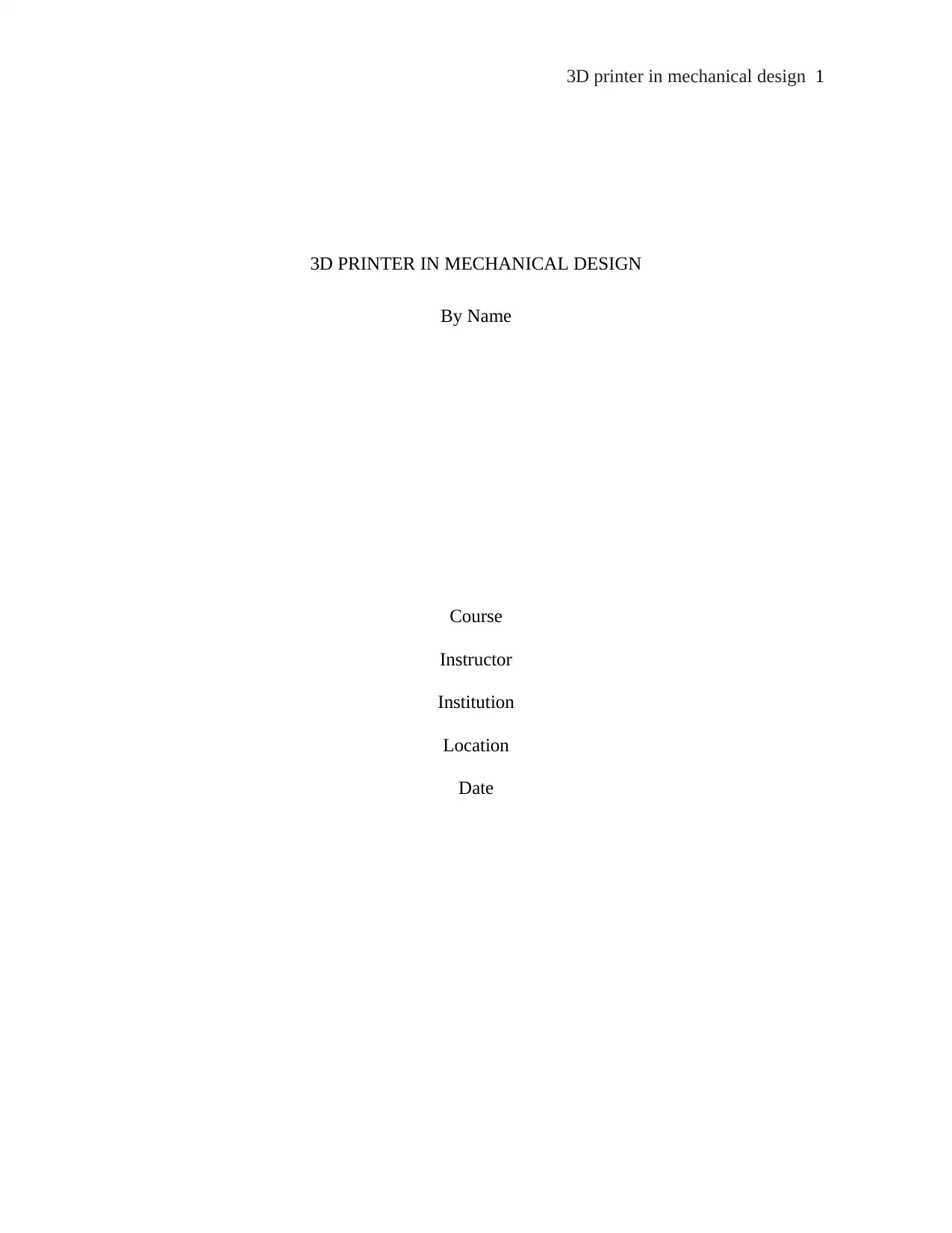
3D printer in mechanical design 1
3D PRINTER IN MECHANICAL DESIGN
By Name
Course
Instructor
Institution
Location
Date
3D PRINTER IN MECHANICAL DESIGN
By Name
Course
Instructor
Institution
Location
Date
Paraphrase This Document
Need a fresh take? Get an instant paraphrase of this document with our AI Paraphraser
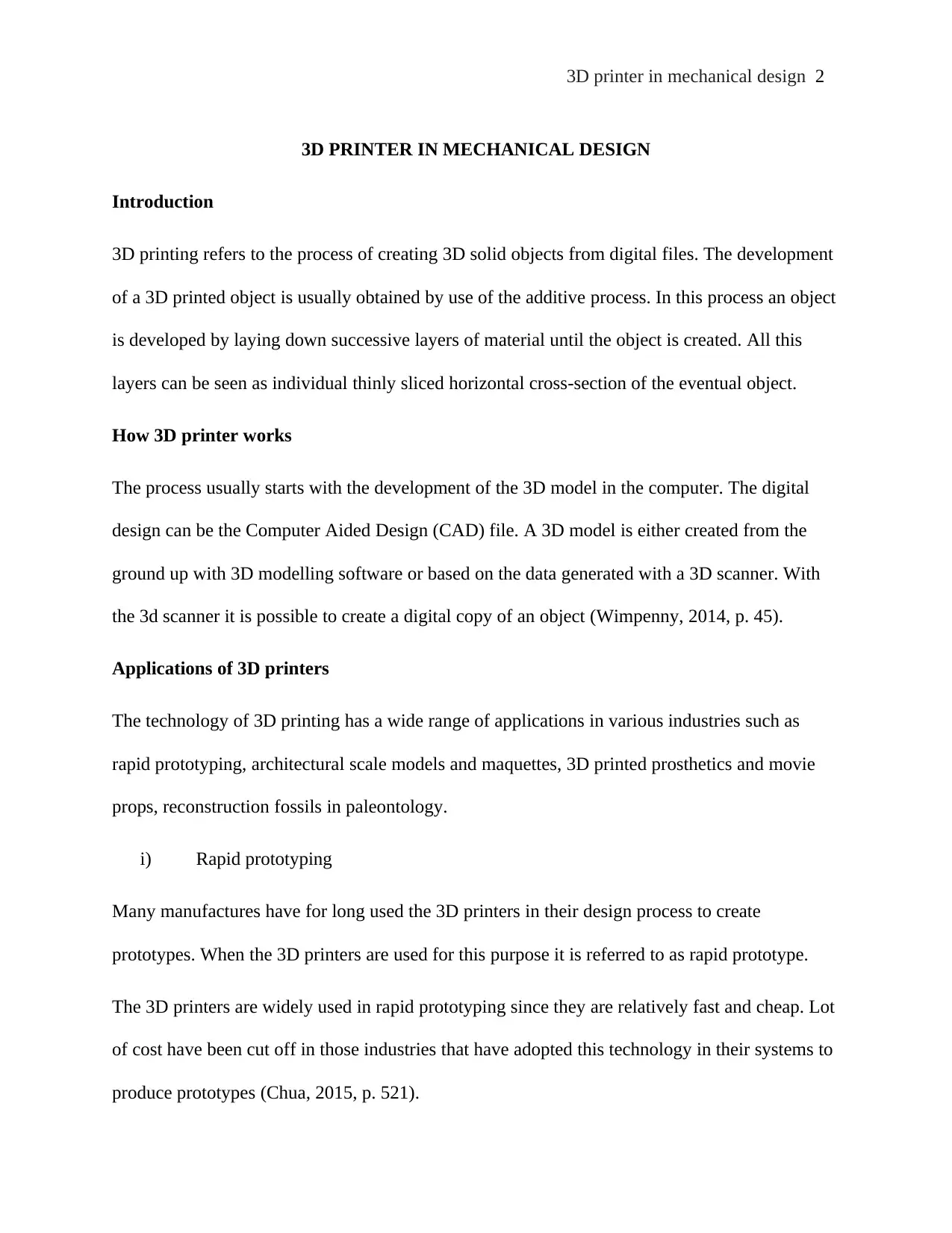
3D printer in mechanical design 2
3D PRINTER IN MECHANICAL DESIGN
Introduction
3D printing refers to the process of creating 3D solid objects from digital files. The development
of a 3D printed object is usually obtained by use of the additive process. In this process an object
is developed by laying down successive layers of material until the object is created. All this
layers can be seen as individual thinly sliced horizontal cross-section of the eventual object.
How 3D printer works
The process usually starts with the development of the 3D model in the computer. The digital
design can be the Computer Aided Design (CAD) file. A 3D model is either created from the
ground up with 3D modelling software or based on the data generated with a 3D scanner. With
the 3d scanner it is possible to create a digital copy of an object (Wimpenny, 2014, p. 45).
Applications of 3D printers
The technology of 3D printing has a wide range of applications in various industries such as
rapid prototyping, architectural scale models and maquettes, 3D printed prosthetics and movie
props, reconstruction fossils in paleontology.
i) Rapid prototyping
Many manufactures have for long used the 3D printers in their design process to create
prototypes. When the 3D printers are used for this purpose it is referred to as rapid prototype.
The 3D printers are widely used in rapid prototyping since they are relatively fast and cheap. Lot
of cost have been cut off in those industries that have adopted this technology in their systems to
produce prototypes (Chua, 2015, p. 521).
3D PRINTER IN MECHANICAL DESIGN
Introduction
3D printing refers to the process of creating 3D solid objects from digital files. The development
of a 3D printed object is usually obtained by use of the additive process. In this process an object
is developed by laying down successive layers of material until the object is created. All this
layers can be seen as individual thinly sliced horizontal cross-section of the eventual object.
How 3D printer works
The process usually starts with the development of the 3D model in the computer. The digital
design can be the Computer Aided Design (CAD) file. A 3D model is either created from the
ground up with 3D modelling software or based on the data generated with a 3D scanner. With
the 3d scanner it is possible to create a digital copy of an object (Wimpenny, 2014, p. 45).
Applications of 3D printers
The technology of 3D printing has a wide range of applications in various industries such as
rapid prototyping, architectural scale models and maquettes, 3D printed prosthetics and movie
props, reconstruction fossils in paleontology.
i) Rapid prototyping
Many manufactures have for long used the 3D printers in their design process to create
prototypes. When the 3D printers are used for this purpose it is referred to as rapid prototype.
The 3D printers are widely used in rapid prototyping since they are relatively fast and cheap. Lot
of cost have been cut off in those industries that have adopted this technology in their systems to
produce prototypes (Chua, 2015, p. 521).
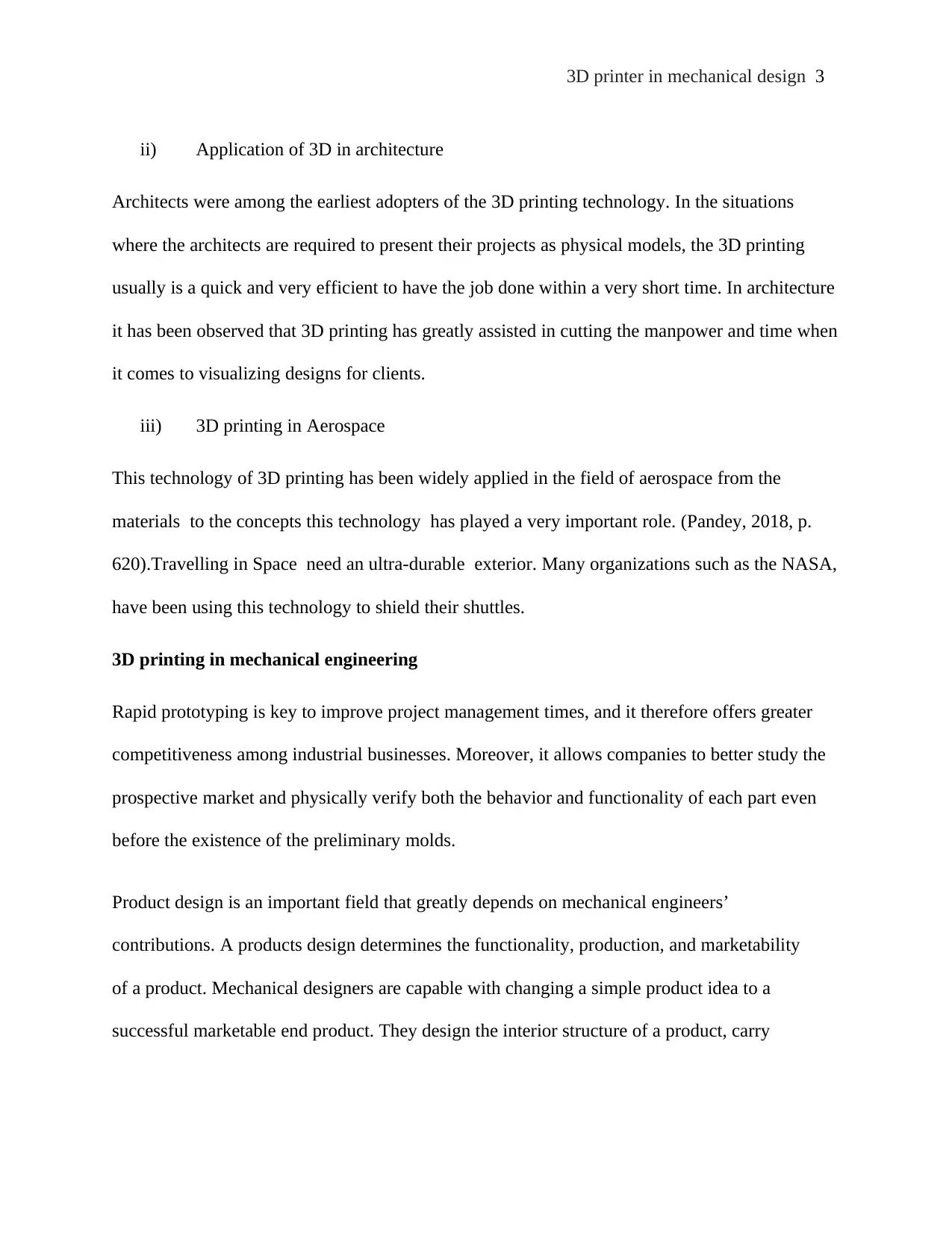
3D printer in mechanical design 3
ii) Application of 3D in architecture
Architects were among the earliest adopters of the 3D printing technology. In the situations
where the architects are required to present their projects as physical models, the 3D printing
usually is a quick and very efficient to have the job done within a very short time. In architecture
it has been observed that 3D printing has greatly assisted in cutting the manpower and time when
it comes to visualizing designs for clients.
iii) 3D printing in Aerospace
This technology of 3D printing has been widely applied in the field of aerospace from the
materials to the concepts this technology has played a very important role. (Pandey, 2018, p.
620).Travelling in Space need an ultra-durable exterior. Many organizations such as the NASA,
have been using this technology to shield their shuttles.
3D printing in mechanical engineering
Rapid prototyping is key to improve project management times, and it therefore offers greater
competitiveness among industrial businesses. Moreover, it allows companies to better study the
prospective market and physically verify both the behavior and functionality of each part even
before the existence of the preliminary molds.
Product design is an important field that greatly depends on mechanical engineers’
contributions. A products design determines the functionality, production, and marketability
of a product. Mechanical designers are capable with changing a simple product idea to a
successful marketable end product. They design the interior structure of a product, carry
ii) Application of 3D in architecture
Architects were among the earliest adopters of the 3D printing technology. In the situations
where the architects are required to present their projects as physical models, the 3D printing
usually is a quick and very efficient to have the job done within a very short time. In architecture
it has been observed that 3D printing has greatly assisted in cutting the manpower and time when
it comes to visualizing designs for clients.
iii) 3D printing in Aerospace
This technology of 3D printing has been widely applied in the field of aerospace from the
materials to the concepts this technology has played a very important role. (Pandey, 2018, p.
620).Travelling in Space need an ultra-durable exterior. Many organizations such as the NASA,
have been using this technology to shield their shuttles.
3D printing in mechanical engineering
Rapid prototyping is key to improve project management times, and it therefore offers greater
competitiveness among industrial businesses. Moreover, it allows companies to better study the
prospective market and physically verify both the behavior and functionality of each part even
before the existence of the preliminary molds.
Product design is an important field that greatly depends on mechanical engineers’
contributions. A products design determines the functionality, production, and marketability
of a product. Mechanical designers are capable with changing a simple product idea to a
successful marketable end product. They design the interior structure of a product, carry
⊘ This is a preview!⊘
Do you want full access?
Subscribe today to unlock all pages.

Trusted by 1+ million students worldwide
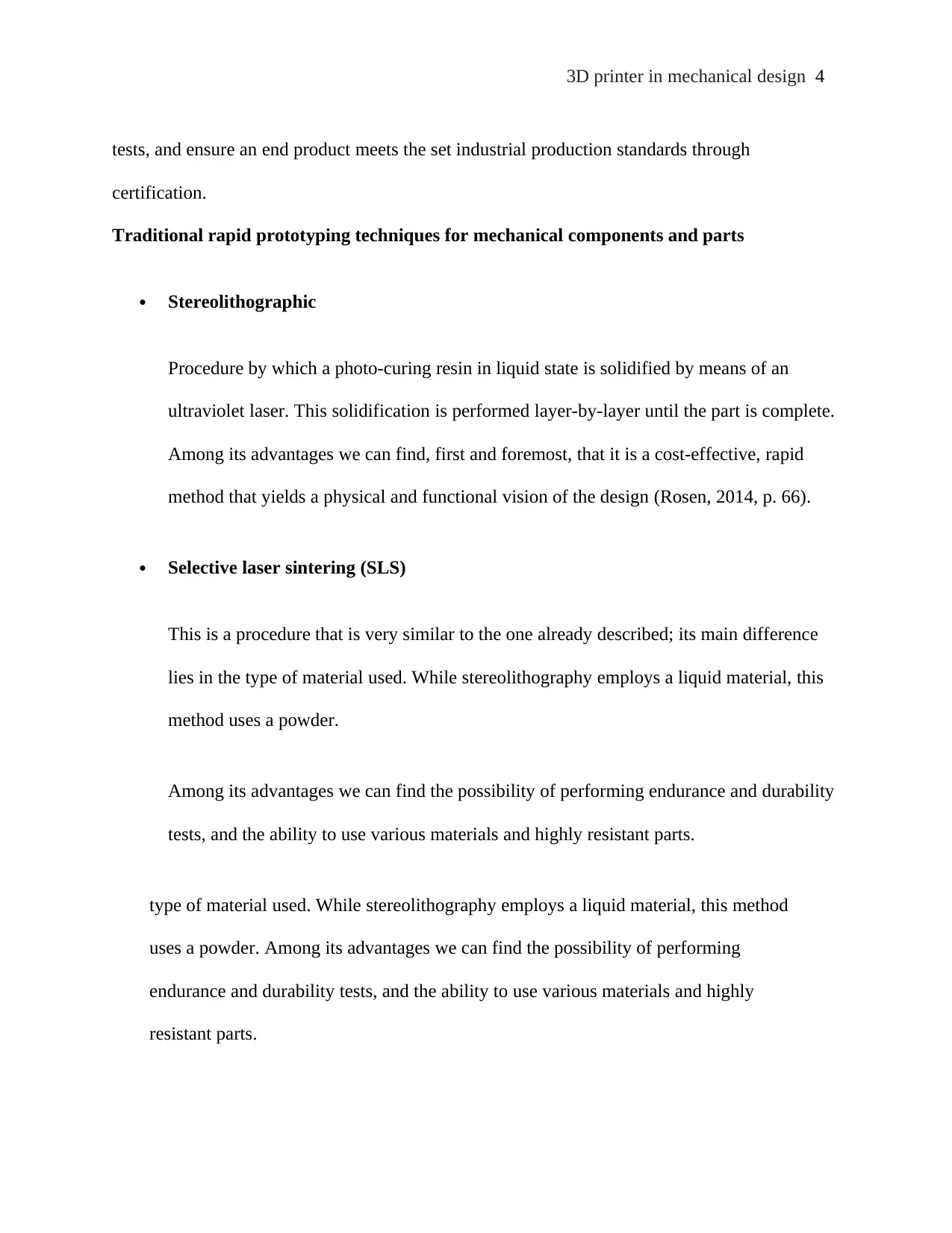
3D printer in mechanical design 4
tests, and ensure an end product meets the set industrial production standards through
certification.
Traditional rapid prototyping techniques for mechanical components and parts
Stereolithographic
Procedure by which a photo-curing resin in liquid state is solidified by means of an
ultraviolet laser. This solidification is performed layer-by-layer until the part is complete.
Among its advantages we can find, first and foremost, that it is a cost-effective, rapid
method that yields a physical and functional vision of the design (Rosen, 2014, p. 66).
Selective laser sintering (SLS)
This is a procedure that is very similar to the one already described; its main difference
lies in the type of material used. While stereolithography employs a liquid material, this
method uses a powder.
Among its advantages we can find the possibility of performing endurance and durability
tests, and the ability to use various materials and highly resistant parts.
type of material used. While stereolithography employs a liquid material, this method
uses a powder. Among its advantages we can find the possibility of performing
endurance and durability tests, and the ability to use various materials and highly
resistant parts.
tests, and ensure an end product meets the set industrial production standards through
certification.
Traditional rapid prototyping techniques for mechanical components and parts
Stereolithographic
Procedure by which a photo-curing resin in liquid state is solidified by means of an
ultraviolet laser. This solidification is performed layer-by-layer until the part is complete.
Among its advantages we can find, first and foremost, that it is a cost-effective, rapid
method that yields a physical and functional vision of the design (Rosen, 2014, p. 66).
Selective laser sintering (SLS)
This is a procedure that is very similar to the one already described; its main difference
lies in the type of material used. While stereolithography employs a liquid material, this
method uses a powder.
Among its advantages we can find the possibility of performing endurance and durability
tests, and the ability to use various materials and highly resistant parts.
type of material used. While stereolithography employs a liquid material, this method
uses a powder. Among its advantages we can find the possibility of performing
endurance and durability tests, and the ability to use various materials and highly
resistant parts.
Paraphrase This Document
Need a fresh take? Get an instant paraphrase of this document with our AI Paraphraser
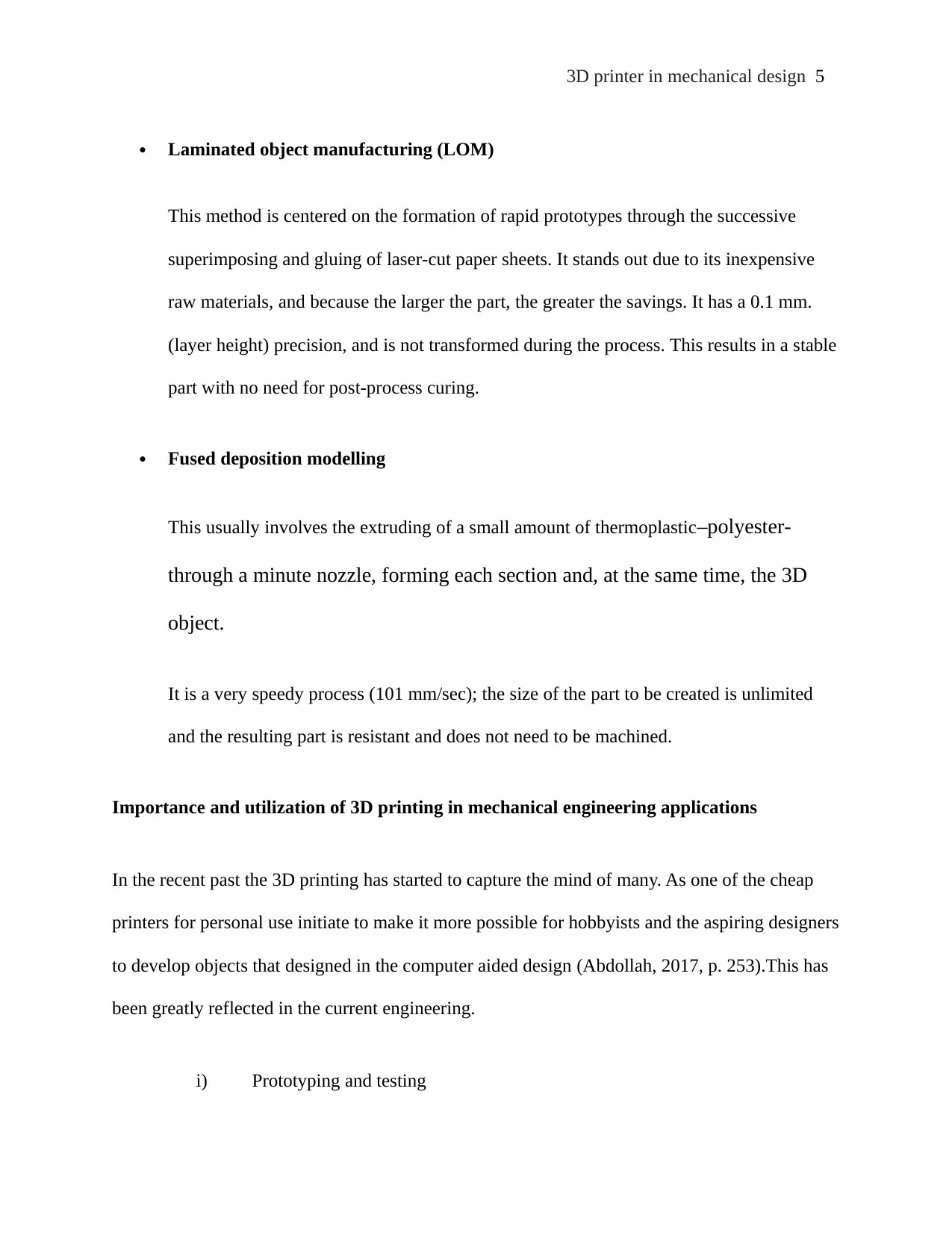
3D printer in mechanical design 5
Laminated object manufacturing (LOM)
This method is centered on the formation of rapid prototypes through the successive
superimposing and gluing of laser-cut paper sheets. It stands out due to its inexpensive
raw materials, and because the larger the part, the greater the savings. It has a 0.1 mm.
(layer height) precision, and is not transformed during the process. This results in a stable
part with no need for post-process curing.
Fused deposition modelling
This usually involves the extruding of a small amount of thermoplastic–polyester-
through a minute nozzle, forming each section and, at the same time, the 3D
object.
It is a very speedy process (101 mm/sec); the size of the part to be created is unlimited
and the resulting part is resistant and does not need to be machined.
Importance and utilization of 3D printing in mechanical engineering applications
In the recent past the 3D printing has started to capture the mind of many. As one of the cheap
printers for personal use initiate to make it more possible for hobbyists and the aspiring designers
to develop objects that designed in the computer aided design (Abdollah, 2017, p. 253).This has
been greatly reflected in the current engineering.
i) Prototyping and testing
Laminated object manufacturing (LOM)
This method is centered on the formation of rapid prototypes through the successive
superimposing and gluing of laser-cut paper sheets. It stands out due to its inexpensive
raw materials, and because the larger the part, the greater the savings. It has a 0.1 mm.
(layer height) precision, and is not transformed during the process. This results in a stable
part with no need for post-process curing.
Fused deposition modelling
This usually involves the extruding of a small amount of thermoplastic–polyester-
through a minute nozzle, forming each section and, at the same time, the 3D
object.
It is a very speedy process (101 mm/sec); the size of the part to be created is unlimited
and the resulting part is resistant and does not need to be machined.
Importance and utilization of 3D printing in mechanical engineering applications
In the recent past the 3D printing has started to capture the mind of many. As one of the cheap
printers for personal use initiate to make it more possible for hobbyists and the aspiring designers
to develop objects that designed in the computer aided design (Abdollah, 2017, p. 253).This has
been greatly reflected in the current engineering.
i) Prototyping and testing
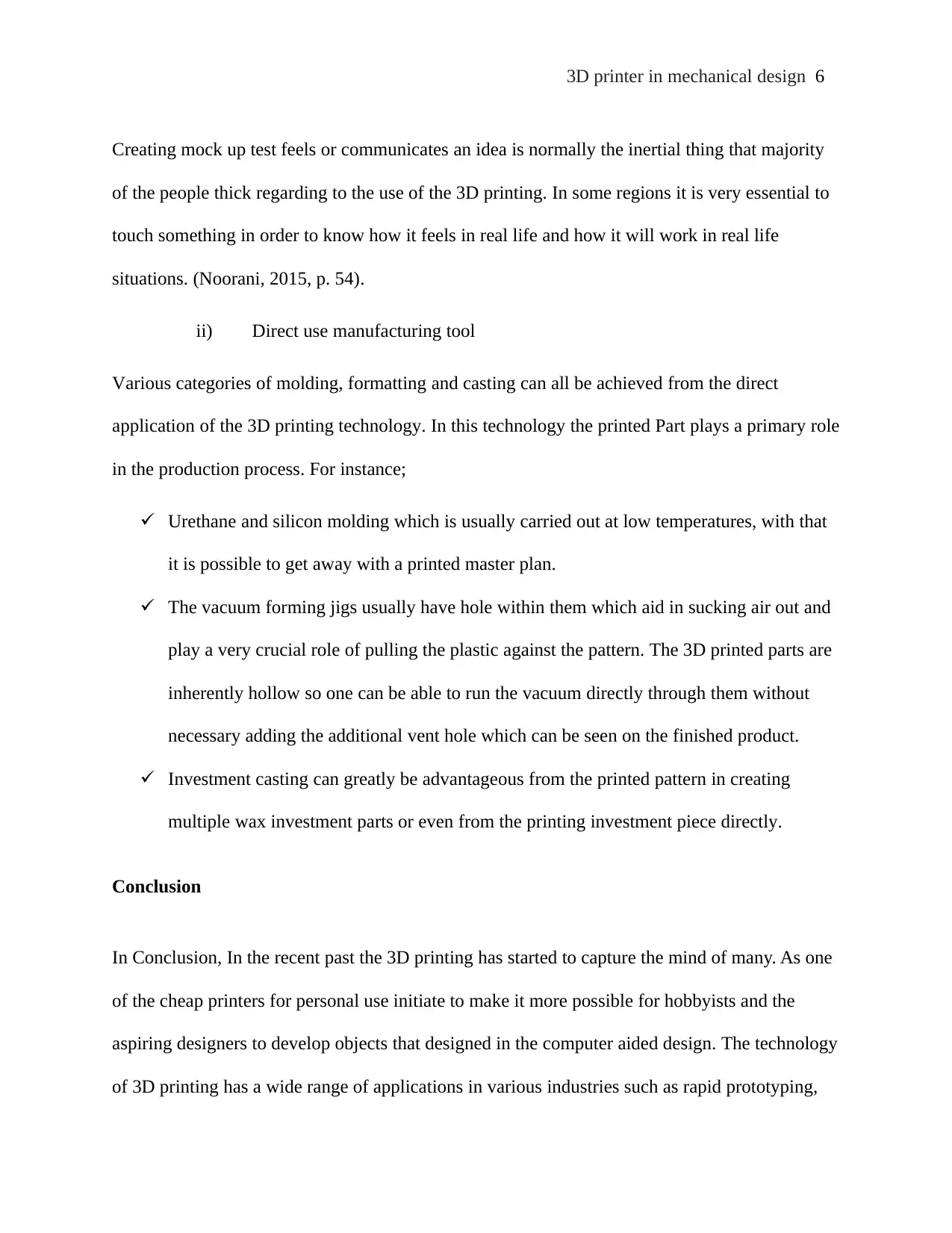
3D printer in mechanical design 6
Creating mock up test feels or communicates an idea is normally the inertial thing that majority
of the people thick regarding to the use of the 3D printing. In some regions it is very essential to
touch something in order to know how it feels in real life and how it will work in real life
situations. (Noorani, 2015, p. 54).
ii) Direct use manufacturing tool
Various categories of molding, formatting and casting can all be achieved from the direct
application of the 3D printing technology. In this technology the printed Part plays a primary role
in the production process. For instance;
Urethane and silicon molding which is usually carried out at low temperatures, with that
it is possible to get away with a printed master plan.
The vacuum forming jigs usually have hole within them which aid in sucking air out and
play a very crucial role of pulling the plastic against the pattern. The 3D printed parts are
inherently hollow so one can be able to run the vacuum directly through them without
necessary adding the additional vent hole which can be seen on the finished product.
Investment casting can greatly be advantageous from the printed pattern in creating
multiple wax investment parts or even from the printing investment piece directly.
Conclusion
In Conclusion, In the recent past the 3D printing has started to capture the mind of many. As one
of the cheap printers for personal use initiate to make it more possible for hobbyists and the
aspiring designers to develop objects that designed in the computer aided design. The technology
of 3D printing has a wide range of applications in various industries such as rapid prototyping,
Creating mock up test feels or communicates an idea is normally the inertial thing that majority
of the people thick regarding to the use of the 3D printing. In some regions it is very essential to
touch something in order to know how it feels in real life and how it will work in real life
situations. (Noorani, 2015, p. 54).
ii) Direct use manufacturing tool
Various categories of molding, formatting and casting can all be achieved from the direct
application of the 3D printing technology. In this technology the printed Part plays a primary role
in the production process. For instance;
Urethane and silicon molding which is usually carried out at low temperatures, with that
it is possible to get away with a printed master plan.
The vacuum forming jigs usually have hole within them which aid in sucking air out and
play a very crucial role of pulling the plastic against the pattern. The 3D printed parts are
inherently hollow so one can be able to run the vacuum directly through them without
necessary adding the additional vent hole which can be seen on the finished product.
Investment casting can greatly be advantageous from the printed pattern in creating
multiple wax investment parts or even from the printing investment piece directly.
Conclusion
In Conclusion, In the recent past the 3D printing has started to capture the mind of many. As one
of the cheap printers for personal use initiate to make it more possible for hobbyists and the
aspiring designers to develop objects that designed in the computer aided design. The technology
of 3D printing has a wide range of applications in various industries such as rapid prototyping,
⊘ This is a preview!⊘
Do you want full access?
Subscribe today to unlock all pages.

Trusted by 1+ million students worldwide
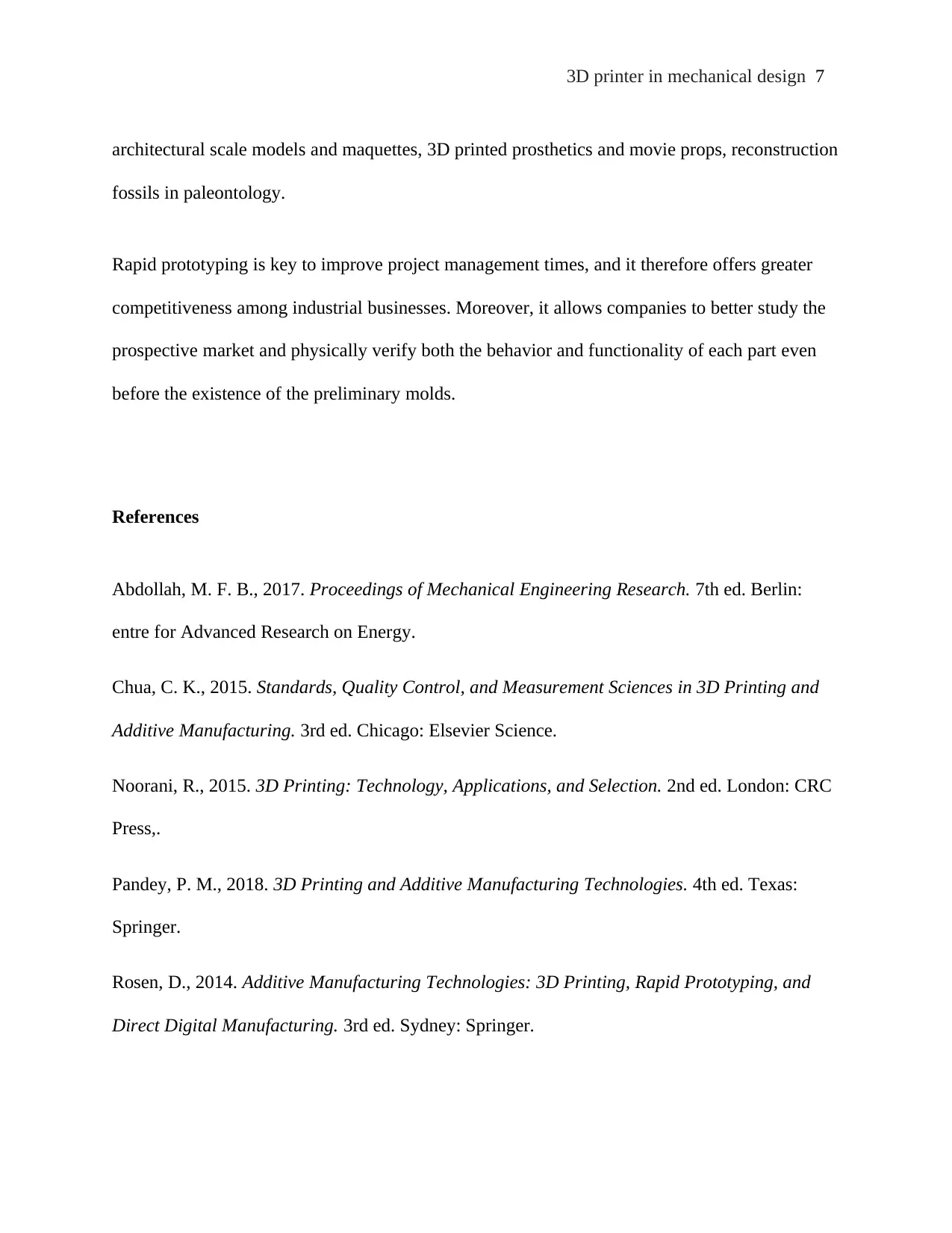
3D printer in mechanical design 7
architectural scale models and maquettes, 3D printed prosthetics and movie props, reconstruction
fossils in paleontology.
Rapid prototyping is key to improve project management times, and it therefore offers greater
competitiveness among industrial businesses. Moreover, it allows companies to better study the
prospective market and physically verify both the behavior and functionality of each part even
before the existence of the preliminary molds.
References
Abdollah, M. F. B., 2017. Proceedings of Mechanical Engineering Research. 7th ed. Berlin:
entre for Advanced Research on Energy.
Chua, C. K., 2015. Standards, Quality Control, and Measurement Sciences in 3D Printing and
Additive Manufacturing. 3rd ed. Chicago: Elsevier Science.
Noorani, R., 2015. 3D Printing: Technology, Applications, and Selection. 2nd ed. London: CRC
Press,.
Pandey, P. M., 2018. 3D Printing and Additive Manufacturing Technologies. 4th ed. Texas:
Springer.
Rosen, D., 2014. Additive Manufacturing Technologies: 3D Printing, Rapid Prototyping, and
Direct Digital Manufacturing. 3rd ed. Sydney: Springer.
architectural scale models and maquettes, 3D printed prosthetics and movie props, reconstruction
fossils in paleontology.
Rapid prototyping is key to improve project management times, and it therefore offers greater
competitiveness among industrial businesses. Moreover, it allows companies to better study the
prospective market and physically verify both the behavior and functionality of each part even
before the existence of the preliminary molds.
References
Abdollah, M. F. B., 2017. Proceedings of Mechanical Engineering Research. 7th ed. Berlin:
entre for Advanced Research on Energy.
Chua, C. K., 2015. Standards, Quality Control, and Measurement Sciences in 3D Printing and
Additive Manufacturing. 3rd ed. Chicago: Elsevier Science.
Noorani, R., 2015. 3D Printing: Technology, Applications, and Selection. 2nd ed. London: CRC
Press,.
Pandey, P. M., 2018. 3D Printing and Additive Manufacturing Technologies. 4th ed. Texas:
Springer.
Rosen, D., 2014. Additive Manufacturing Technologies: 3D Printing, Rapid Prototyping, and
Direct Digital Manufacturing. 3rd ed. Sydney: Springer.
Paraphrase This Document
Need a fresh take? Get an instant paraphrase of this document with our AI Paraphraser

3D printer in mechanical design 8
Wimpenny, D. I., 2014. Advances in 3D Printing & Additive Manufacturing Technologies. 1st
ed. Chicago: Springer.
Wimpenny, D. I., 2014. Advances in 3D Printing & Additive Manufacturing Technologies. 1st
ed. Chicago: Springer.
1 out of 8
Related Documents
Your All-in-One AI-Powered Toolkit for Academic Success.
+13062052269
info@desklib.com
Available 24*7 on WhatsApp / Email
![[object Object]](/_next/static/media/star-bottom.7253800d.svg)
Unlock your academic potential
Copyright © 2020–2025 A2Z Services. All Rights Reserved. Developed and managed by ZUCOL.





